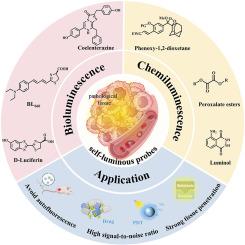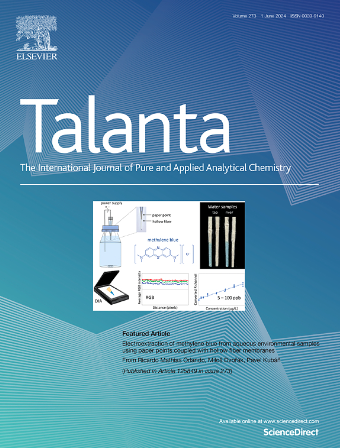自发光探针:照亮生物医学突破之路
IF 6.1
1区 化学
Q1 CHEMISTRY, ANALYTICAL
引用次数: 0
摘要
自发光探针,包括化学发光和生物发光类型,分别通过化学或酶催化反应产生光。与光致发光探针不同,它们不受外部激励,消除了自身荧光,提高了成像中的信噪比。最近的研究强调了它们在检测和成像生物标志物、活性氧(ROS)、重金属和其他分析物方面的多功能性。本文系统地综述了目前自发光探针的发光机制和构效关系,并重点介绍了自发光探针在检测、成像和治疗等生物医学应用方面的最新进展。此外,我们讨论了新兴趋势和未来方向,旨在激发多功能应用新材料的发展,并促进这些技术在研究和临床环境中的广泛采用。本文章由计算机程序翻译,如有差异,请以英文原文为准。

Self-luminous probes: Illuminating the path to biomedical breakthroughs
Self-luminous probes, encompassing chemiluminescent and bioluminescent types, generate light through chemical or enzyme-catalyzed reactions, respectively. Unlike photoluminescent probes, their independence from external excitation eliminates autofluorescence and enhances signal-to-noise ratios in imaging. Recent research highlights their versatility in detecting and imaging biomarkers, reactive oxygen species (ROS), heavy metals, and other analytes. This review systematically examines the luminescence mechanisms and structure-activity relationships of current self-luminous probes, and highlights recent progress in their biomedical applications, including detection, imaging, and theranostics. Furthermore, we discuss emerging trends and future directions, aiming to inspire the development of novel materials for multifunctional applications and promote the broader adoption of these technologies in research and clinical settings.
求助全文
通过发布文献求助,成功后即可免费获取论文全文。
去求助
来源期刊

Talanta
化学-分析化学
CiteScore
12.30
自引率
4.90%
发文量
861
审稿时长
29 days
期刊介绍:
Talanta provides a forum for the publication of original research papers, short communications, and critical reviews in all branches of pure and applied analytical chemistry. Papers are evaluated based on established guidelines, including the fundamental nature of the study, scientific novelty, substantial improvement or advantage over existing technology or methods, and demonstrated analytical applicability. Original research papers on fundamental studies, and on novel sensor and instrumentation developments, are encouraged. Novel or improved applications in areas such as clinical and biological chemistry, environmental analysis, geochemistry, materials science and engineering, and analytical platforms for omics development are welcome.
Analytical performance of methods should be determined, including interference and matrix effects, and methods should be validated by comparison with a standard method, or analysis of a certified reference material. Simple spiking recoveries may not be sufficient. The developed method should especially comprise information on selectivity, sensitivity, detection limits, accuracy, and reliability. However, applying official validation or robustness studies to a routine method or technique does not necessarily constitute novelty. Proper statistical treatment of the data should be provided. Relevant literature should be cited, including related publications by the authors, and authors should discuss how their proposed methodology compares with previously reported methods.
 求助内容:
求助内容: 应助结果提醒方式:
应助结果提醒方式:


